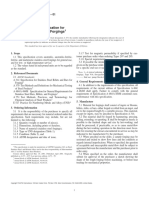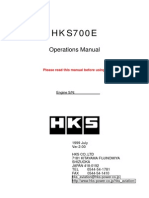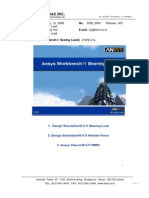Professional Documents
Culture Documents
Abrasive Wear in Pumps
Abrasive Wear in Pumps
Uploaded by
Yury0 ratings0% found this document useful (0 votes)
63 views16 pagesOriginal Title
Abrasive wear in pumps
Copyright
© © All Rights Reserved
Available Formats
PDF or read online from Scribd
Share this document
Did you find this document useful?
Is this content inappropriate?
Report this DocumentCopyright:
© All Rights Reserved
Available Formats
Download as PDF or read online from Scribd
Download as pdf
0 ratings0% found this document useful (0 votes)
63 views16 pagesAbrasive Wear in Pumps
Abrasive Wear in Pumps
Uploaded by
YuryCopyright:
© All Rights Reserved
Available Formats
Download as PDF or read online from Scribd
Download as pdf
You are on page 1of 16
ABRASIVE WEAR IN PUMPS-
A TRIBOMETRIC APPROACH TO IMPROVE PUMP LIFE
by
Gerhard Vetter
Professor
Ralph Kiebling
and
Wolfgang Wirth
Research Engineer
University of Erlangen-Nuremberg
Erlangen, Germany
Gerhard Vetter obtained his Dipl. Ing
degree (Mechanical Engineering) at
Technische Universitat Karlsruhe,
Germany. After some years as a Research
Engincer in turbomachinery at the same
university, he joined Lewa, Leonberg
(Germany) as head of the Research and
Development Deparment. He became
Chief Engineer and, in 1970, Technical
Managing Director. In 1981, he accepted
chair (professorship) for Apparatus and
‘Chemical Machinery atthe University of Erlangen-Nuremberg. He
is a corresponding member of the International Pump User’
Sympostim Advisory Committee
Prof Netter has dedicated more than 25 years 10 research, devel
‘opment and design of pumps and metering equipment He has been
‘one of the pioneers in diaphragm pumps development. Many
>apers, patents, and contributions to textbooks, some dealing with
basics lke cavitation, fatigue, pulsation, vibrations, abrasive wear
‘and metering accuracy, have established his reputation asa pump
specialist. The well equipped laboratory at University of
Erlangen-Nuremberg performs research work on pump and
‘metering subjects
Ralph Kiefling studied inthe
Department of Chemical Engineering at
the University Erlangen-Nurembers, Ce
‘many. Afer receiving his Dipl-Ing. degree
{in 1992, he joined the Institute of Apparatus
‘and Chemical Mackinery at the same
University. His research subjects were
Inydroabrasive wear in rotary positive dis-
placement and centrifugal — pumps,
fespecially in clearance seals, On this topic
he prepared a doctoral thesis in 1994 (Dr:
Ing. degre)
us
Wolfgang Wish obtained his Dipl-Ing
Unix: degree (Chemical Engineering) at
the university of Erlangen-Nurembers,
Germany in 1986, and subsequently joined
the Institute of Apparatus and Chemical
Machinery at the same institution. AS a
research engineer, he prepared a thesis
f ‘about methods for modelling of the
Inydraulic and tribologic properties of pro-
gressing. cavity. pumps and received his
Deng. degree in 1993,
ABSTRACT
‘The reduction of abrasive wear and extension of the endurance
‘of pumps requires a system analysis. Various pump types demon-
sirate different tribological systems under abrasive Wear, which are
basically dominated by siding, jet, and stamping wear types. The
‘morphological approach yields an understanding of why wear
tacks have to be considered predominantly.
ances. and limitations for wear and endurance prediction
based on tibometric simulation are discussed. As quantitative pre:
diction is not always possible, the method of relative suitability
turns out to be a good to
‘As experience shows predominant jet and sliding wear in
pumps, these two wear types are discussed closer.
‘Avgood example fora tibological system dominated by sling
wear is the progressing eavity pump. Several tribological simula:
tions, including parameter studies are discussed, evaluated, and
‘compared that demonstrate strategies for pump improvements,
‘Jet wear dominated tribological systems are special clearances
in rotary pumps that are discussed with respect to wear phenomena
and tribological simulation. Furthermore, methods of wear predic
tion for centrifugal pumps in general, based on parameter studies
‘with jt wibometes, are explained.
‘The discussion is ended with an extended analysis of various
materials, different stel, and sintered types in solid or layered
at PROCEEDINGS OF THE THIRTEENTH INTERNATIONAL PUMP USERS SYMPOSIUM
along with plastics for application in pumps against hydroabrasive
‘wear, Following the method of relative suitability based on tibo-
‘metric data for jet and sliding wear.
INTRODUCTION
‘There are many applications for pumps in processing and
conveying systems, where suspensions, slurries, of particle conta
‘minated Mluids have to be handled. The interaction of abrasives
with the pump pans is characteristcally for the various pump
types, demonstrating at certain locations wear rates by erosion that
‘may cause severe reduction of pump lifecycle
“Typical failures are increased clearances at ntermeshing sealing
parts implementing larger internal leak losses, as is shown in
Figures and 2 [1], for the rotor of a progressing cavity and the
valve seat of a reciprocating pump (2), The alteration ofthe rotor
shape with centrifugal pumps, be it surface quality or flow channel
‘geometry in genera, is strongly influencing pump petformance
and function (Figure 3).
©
View X
Figure 1. Wear at the Rotor of a Progressing Cavity. Pump
(Helical Wear Traces)
Abrasive wear which is dreetly responsible for the reduction of
‘energetic and volumetric efficiency life cycle time, malfunction,
Safety and economy has to be avoided by a tribological analysis of
the endangered pump locations
‘The authors feel that this paper will stimulate the application of
system analysis and tribometry to achieve the extension of purnp
lite cycles.
Basics of Tribometric Simulation
‘Wear, per definition isthe permanent material loss atthe surface
‘of pump components by mechanical and combined chemical
action, representing not a material bt a systems characteristic. The
‘physical Wear mechanisms comprise adhesion, abrasion, surface
fatigue, tibo oxidation and tibo corrosion effects [3]. In general,
ibologieal systems by superposition of several wear mechanisms
demonstrate typical wear types like jet, sliding, rolling, resp.
stamping wear.
‘As an example, the tribological system is shown in Figure 4 of
sliding wear, with the system components the intermeshing com-
ponents (positions 1 and 2) the fluid (position 3), the particles
(position 4) and other characteristics like temperature, chemical
and physical fluid, and particle properties. Bach pump type demon-
‘rates one or more characterstially tribological systems that have
tbe analyzed in order to recognize the predominating important
parameters on wear.
Figure 2. Local Jet Wear Traces at the Metallic Seat of a
Reciprocating Pump Check Valve.
WN 1: HV, geometry
S 2: HV, geometry
3 3: pH. n, 8. ¢5
yy 4: Hp dp
L, 7 *
Figure 4. Tribological Sliding Wear System: I) wear component
2)wear component; 3) fluid; 4) abrasive particle.
[ABRASIVE WEAR IN PUMPS-A TRIBOMETRIC APPROACH TO IMPROVE PUMP LIFE Ms
‘The further explanation will exclusively concen
Inydroabrasive tribological systems.
‘The basic idea of tbometrc simulation isto analyze the pump
‘with respect to the relevant wear locations, in order to find out the
predominantly active tribological systems and methods for their
‘wibometrc simulation with flexible and simple tes is.
Wear Locations
Considering a number of representative pump types (Figure 5)
including centrifugal pumps, rotary, and reciprocating displace:
‘ment pumps shows that hydroabrasive tribological systems in
pumps are mainly based on three wear types: jet, sliding, and
stamping or rolling wear
Figure 5. Morphology of Wear Locations for Various Pump Types:
4) centrifugal: b) nwo screw: c) three lobed) progressing cavity; e)
sliding vane: ) gear: g) reeiprocating (plunger seal) h) recip
cating (check valve.
‘The hydroabrasive jet wear type is characteristic at all types of
flow channels in impellers oF housings with or without blades
(Figure (a), the particles may move parallel or angular relative to
the wearing walls,
‘A special case of hydroabrasive jet wear isthe low in annular
$00) by heat treatment, bt corrosion res
tance and ductility are reduced. For a number of applications these
:materals ae a good choice for hydroabrasive low corrosion attack.
+ Grow G3: Special alloys with hard carbidie inclusions. ‘The
basic matrix contains hard carbidic inclusions. either by precipita-
‘ion of by external implementation as particles. The hard partiles,
for phase areas represent together with the basic material matrix a
reinforced structure against wear attack, ‘These materials are
available as castings or welded resp. sprayed coatings. Hardness is,
high (500 © HY < 1000)
+ Grow G4: Hart metals and ceramics. Hard metals are mainly
based on carbide particles embedded within « metallic matrix
‘They can be used either as sintered pars oF as sprayed coatings.
High wear resistance is paired with britleness and difficult
machining (HV > 1000),
156 PROCEEDINGS OF THE THIRTEENTH INTERNATIONAL PUMP USERS SYMPOSIUM
ey
: emmeer] NA
cmt
ia Bee, 2
Prlila ”
—
Figure 31. Linear Wear Rate Related to the Hardness of the
‘Material: a) sliding wear; b) parallel jet wear (bore): c) orthogo-
nal et wear
+ Group G5: Plasiomers and elastomers. Corrosion and, wear
resistance make these materials attractive for lining or coating of
ump components,
Material Hardness and Wear Resistance
For most of the materials, except of the plastic type materials,
the hardness/wear correlation i definite. For comparable tribolog
ieal conditions that with sliding and orthogonal, respectively,
Parallel jet wear very similar characteristics ofthe material groups
G1 ~ Ge are shown in Figure 31
Group GI (HV < 500): Increased hardness does not reduce wear
rate much, as the tribological system in on the high wear level (Ry
>I
Group G2 (HV > 500): Increased hardness shows a stronger
influence on wear rate. Double hardness yields sliding. wear
reduction by a factor 20 to 40 and jet wear reduction by factor 2.0
50,
Group G3 (HV > 500): Alloys with carbide inclusions demon-
strate at nominally equal hardness improved wear resistance, 28
Tocal hard inclusions aet as a shield
‘Group G4 (HV > 1200): Due tothe transition ofthe wibological
system from the high tothe low wear level (Ry, 1), the wear Fates
are reduced substantially by factor 100 and more.
‘The similarity of wibometric test results i clearly demonstrated
in Figure 31 with respect to the relative suitability of materials
‘This is also true for the results ofthe rotary clearance tribometer
(Figure 32), From Figure 31(b) and (©) yield the great difference in
wear rate between parallel (= 0) and orthogonal («= 90 degrees)
Flow direction (Factor 10 and more!)
Figure 32. Relative Material Suitability based on Different
Trbomeiric Data
[As the reported results are related 10 definite tribosystem
(particle characterisation, concentration, hardness etc), they are,
therefore, not ditectly transformable to ether conditions,
‘Material Suitability and Optimization
There are some possiblities to improve material hardness (HV
= 800) by various (surface) hardening. processes (thermal
treatment, nitration ete). A further step is the implementation of
hard particles, eg, carbides like TC, Cr4Ca, into a metallic matrix
(CoCr, NiCh) The shielding mechanism for sliding and jet wear is,
‘demonstrated in Figure 33.
tis possible for certain types of stainless cast steels to control
the precipitation of hard carbides by thermal treatment in a manner
‘that an improvement of wear resistance results due tothe shielding
cfects mentioned previously
ABRASIVE WEAR IN PUMPS-A TRIBOMETRIC APPROACH TO IMPROVE PUMP LIFE ist
Figure 33. Protective Effect of Carbide Deposits in Cases of Jet
Wear
CONCLUSIONS
Various pump types demonstrate characteristic tribological
systems at definite lations, dominatingly based on sliding o jt
wear attack. Evidently for many pump features, it i feasible 10
You might also like
- The Subtle Art of Not Giving a F*ck: A Counterintuitive Approach to Living a Good LifeFrom EverandThe Subtle Art of Not Giving a F*ck: A Counterintuitive Approach to Living a Good LifeRating: 4 out of 5 stars4/5 (5866)
- The Gifts of Imperfection: Let Go of Who You Think You're Supposed to Be and Embrace Who You AreFrom EverandThe Gifts of Imperfection: Let Go of Who You Think You're Supposed to Be and Embrace Who You AreRating: 4 out of 5 stars4/5 (1094)
- Never Split the Difference: Negotiating As If Your Life Depended On ItFrom EverandNever Split the Difference: Negotiating As If Your Life Depended On ItRating: 4.5 out of 5 stars4.5/5 (866)
- Grit: The Power of Passion and PerseveranceFrom EverandGrit: The Power of Passion and PerseveranceRating: 4 out of 5 stars4/5 (597)
- Hidden Figures: The American Dream and the Untold Story of the Black Women Mathematicians Who Helped Win the Space RaceFrom EverandHidden Figures: The American Dream and the Untold Story of the Black Women Mathematicians Who Helped Win the Space RaceRating: 4 out of 5 stars4/5 (909)
- Shoe Dog: A Memoir by the Creator of NikeFrom EverandShoe Dog: A Memoir by the Creator of NikeRating: 4.5 out of 5 stars4.5/5 (543)
- The Hard Thing About Hard Things: Building a Business When There Are No Easy AnswersFrom EverandThe Hard Thing About Hard Things: Building a Business When There Are No Easy AnswersRating: 4.5 out of 5 stars4.5/5 (352)
- Elon Musk: Tesla, SpaceX, and the Quest for a Fantastic FutureFrom EverandElon Musk: Tesla, SpaceX, and the Quest for a Fantastic FutureRating: 4.5 out of 5 stars4.5/5 (474)
- Her Body and Other Parties: StoriesFrom EverandHer Body and Other Parties: StoriesRating: 4 out of 5 stars4/5 (824)
- The Emperor of All Maladies: A Biography of CancerFrom EverandThe Emperor of All Maladies: A Biography of CancerRating: 4.5 out of 5 stars4.5/5 (272)
- The Sympathizer: A Novel (Pulitzer Prize for Fiction)From EverandThe Sympathizer: A Novel (Pulitzer Prize for Fiction)Rating: 4.5 out of 5 stars4.5/5 (122)
- The Little Book of Hygge: Danish Secrets to Happy LivingFrom EverandThe Little Book of Hygge: Danish Secrets to Happy LivingRating: 3.5 out of 5 stars3.5/5 (411)
- The World Is Flat 3.0: A Brief History of the Twenty-first CenturyFrom EverandThe World Is Flat 3.0: A Brief History of the Twenty-first CenturyRating: 3.5 out of 5 stars3.5/5 (2268)
- The Yellow House: A Memoir (2019 National Book Award Winner)From EverandThe Yellow House: A Memoir (2019 National Book Award Winner)Rating: 4 out of 5 stars4/5 (98)
- Devil in the Grove: Thurgood Marshall, the Groveland Boys, and the Dawn of a New AmericaFrom EverandDevil in the Grove: Thurgood Marshall, the Groveland Boys, and the Dawn of a New AmericaRating: 4.5 out of 5 stars4.5/5 (268)
- A Heartbreaking Work Of Staggering Genius: A Memoir Based on a True StoryFrom EverandA Heartbreaking Work Of Staggering Genius: A Memoir Based on a True StoryRating: 3.5 out of 5 stars3.5/5 (232)
- Team of Rivals: The Political Genius of Abraham LincolnFrom EverandTeam of Rivals: The Political Genius of Abraham LincolnRating: 4.5 out of 5 stars4.5/5 (235)
- On Fire: The (Burning) Case for a Green New DealFrom EverandOn Fire: The (Burning) Case for a Green New DealRating: 4 out of 5 stars4/5 (74)
- A473 PDFDocument5 pagesA473 PDFYury100% (1)
- The Unwinding: An Inner History of the New AmericaFrom EverandThe Unwinding: An Inner History of the New AmericaRating: 4 out of 5 stars4/5 (45)
- The Influence of Geometry and Grooving On The Measured Temperatures of Engine Crankshaft BearingsDocument8 pagesThe Influence of Geometry and Grooving On The Measured Temperatures of Engine Crankshaft BearingsYuryNoch keine Bewertungen
- Evaluation of Coatins For Resistance To Abrasive and Adhesive Wear in Pump ComponentsDocument8 pagesEvaluation of Coatins For Resistance To Abrasive and Adhesive Wear in Pump ComponentsYuryNoch keine Bewertungen
- An FEM Based Approach To Crankshaft Dynamics and Life EstimationDocument15 pagesAn FEM Based Approach To Crankshaft Dynamics and Life EstimationYuryNoch keine Bewertungen
- DLC Coatings On Sintered SiCDocument6 pagesDLC Coatings On Sintered SiCYuryNoch keine Bewertungen
- MDESIGN Mathcad WhitepaperDocument25 pagesMDESIGN Mathcad WhitepaperYury0% (1)
- API Flushing PlansDocument2 pagesAPI Flushing Plansmagedtag100% (14)
- Notes08 Turbulence Flow in Thin FilmsDocument27 pagesNotes08 Turbulence Flow in Thin FilmsYuryNoch keine Bewertungen
- Christian Kim Christiansen PHD ThesisDocument197 pagesChristian Kim Christiansen PHD ThesisYuryNoch keine Bewertungen
- HPFEM MOOC - Module FEM in Science and Society: Reference TextDocument9 pagesHPFEM MOOC - Module FEM in Science and Society: Reference TextYuryNoch keine Bewertungen
- HKS700E Operating ManualDocument34 pagesHKS700E Operating ManualYuryNoch keine Bewertungen
- Ansys Workbench Bearing LoadDocument6 pagesAnsys Workbench Bearing LoadYuryNoch keine Bewertungen
- Ansys Mechanical PostProcessingDocument28 pagesAnsys Mechanical PostProcessingYuryNoch keine Bewertungen





















































